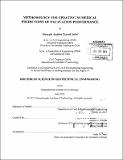Methodology for updating numerical predictions of excavation performance
Author(s)
Corral Jofré, Gonzalo Andrés
DownloadFull printable version (101.3Mb)
Other Contributors
Massachusetts Institute of Technology. Department of Civil and Environmental Engineering.
Advisor
Andrew J. Whittle.
Terms of use
Metadata
Show full item recordAbstract
Due to the usual limitations in site investigations and measurements of soil properties, simplified constitutive models are routinely used in geotechnical analyses for the design of excavation support systems. However, monitoring data provides additional information on the performance of these support systems during construction. This thesis proposes a rational framework for updating constitutive model input parameters in finite element predictions of soil-structure interaction based on the monitoring data. The goal of this methodology is to provide an objective procedure that can be used during construction to update the instrument pre-set trigger levels that are used to control construction. In this way, the methodology aims to preserve safety by increasing confidence in the parameters controlling performance, and to mitigate impacts of unnecessary work stoppages. The proposed methodology is designed to handle diverse designs, ground conditions, and sources of information during construction to operate within existing construction project management procedures (based on trigger levels for individual field measurements). The framework comprises three key components: 1) rational sensitivity analyses (exploring full realistic search spaces for model parameters); 2) error structures of field measurements (maximum likelihood approach); and 3) inverse analyses based on heuristic optimization methods (genetic algorithms). The proposed methodology is evaluated for a well-instrumented excavation project in South Boston (MBTA Courthouse Station, South Piers Transitway project) comprising a floating diaphragm wall, underlain by soft, normally consolidated Boston Blue Clay and supported by five levels of cross-lot bracing. This project has a very low margin of safety against basal instability, but was completed successfully in 2003. Numerical analyses using a conventional linearly-elastic perfectly-plastic (Mohr-Coulomb; MC) soil model are updated using a combination of wall deflection, ground movement, pore pressure and strut load data through the full depth of the excavation. While the proposed procedure produces improved agreement between predictions and measurements, based on reasonable updating of individual input parameters, MC model limitations clearly produce compromises among the measured parameters. The results have been compared with predictions from a more complex elasto-plastic soil model, MIT-E3. In this case, the model input parameters are derived from an extensive laboratory test program (Ladd et al. 1999) and principal uncertainties relate to the insitu stress history profile. Results from the MIT-E3 model show more consistent agreement with the field measurements and achieve comparable accuracy to the more approximate MC model (with parameter updating). The results show the effectiveness of the proposed updating procedure, but also highlight the challenge of updating predictions using simplified models of soil behavior. The study also confirms the value of using more advanced constitutive models calibrated using high quality laboratory tests. Further studies are now needed to evaluate how the proposed updating procedure can mitigate cases where the measured performance deviates from prior predictions and causes interruption of the construction process.
Description
Thesis (Sc. D. in Geotechnical Engineering)--Massachusetts Institute of Technology, Department of Civil and Environmental Engineering, 2013. Cataloged from PDF version of thesis. Includes bibliographical references.
Date issued
2013Department
Massachusetts Institute of Technology. Department of Civil and Environmental EngineeringPublisher
Massachusetts Institute of Technology
Keywords
Civil and Environmental Engineering.